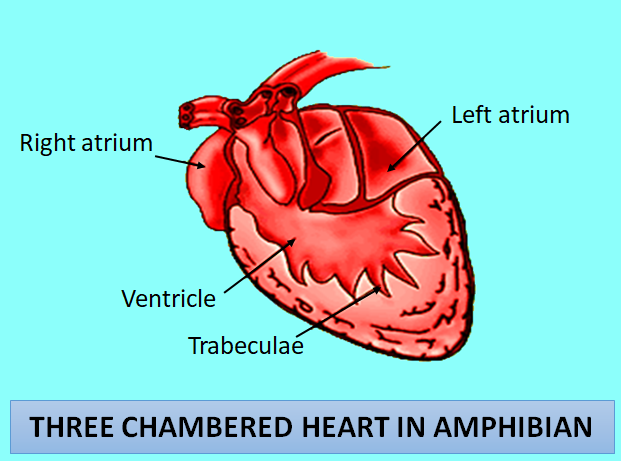
Salamander has a _________ heart
(a)2 chambered
(b)3 chambered
(c)4 chambered
(d)1 chambered
Answer
498.3k+ views
Hint: Salamanders belong to the class Amphibia. In all the amphibians partial mixing of oxygenated and deoxygenated blood is seen in their hearts. They have an incomplete double circulatory system.
Complete answer:
Amphibians and most of the reptiles have a three-chambered heart. The amphibian hearts have two atria and a single ventricle. These animals also have separate blood vessels for oxygenating the blood and then deliver it to the body. Deoxygenated blood returning from the body is emptied into the right atrium of the heart. From there, the blood is then conducted to the ventricle and pumped to the lungs.
Amphibian lungs have a balloon-like structure where the gaseous exchange is minimum. Most of the gaseous exchange occurs by moist skin.
Additional Information: After picking up the oxygen and getting rid of carbon dioxide present in the lungs, blood returns to the heart and empties into the organism’s left atrium. The blood then enters the ventricle for the second time and is pumped out to the body. This second trip of the blood through the heart keeps blood pressure strong and blood flows rapidly as blood is pumped to the tissues, which ultimately helps the blood to deliver the oxygen more efficiently.

So, the answer is, “3 chambered”
Note: -Most amphibians and reptiles show three-chambered hearts while birds and mammals show a four-chambered heart with a clear division of the oxygenated and deoxygenated blood.
-However, crocodiles have a four-chambered heart even though it is a reptile.
-This helps the crocodile to adapt to most of its life underwater and being oxygen efficient so that it can have less breathing cycles.
Complete answer:
Amphibians and most of the reptiles have a three-chambered heart. The amphibian hearts have two atria and a single ventricle. These animals also have separate blood vessels for oxygenating the blood and then deliver it to the body. Deoxygenated blood returning from the body is emptied into the right atrium of the heart. From there, the blood is then conducted to the ventricle and pumped to the lungs.
Amphibian lungs have a balloon-like structure where the gaseous exchange is minimum. Most of the gaseous exchange occurs by moist skin.
Additional Information: After picking up the oxygen and getting rid of carbon dioxide present in the lungs, blood returns to the heart and empties into the organism’s left atrium. The blood then enters the ventricle for the second time and is pumped out to the body. This second trip of the blood through the heart keeps blood pressure strong and blood flows rapidly as blood is pumped to the tissues, which ultimately helps the blood to deliver the oxygen more efficiently.

So, the answer is, “3 chambered”
Note: -Most amphibians and reptiles show three-chambered hearts while birds and mammals show a four-chambered heart with a clear division of the oxygenated and deoxygenated blood.
-However, crocodiles have a four-chambered heart even though it is a reptile.
-This helps the crocodile to adapt to most of its life underwater and being oxygen efficient so that it can have less breathing cycles.
Latest Vedantu courses for you
Grade 11 Science PCM | CBSE | SCHOOL | English
CBSE (2025-26)
School Full course for CBSE students
₹41,848 per year
EMI starts from ₹3,487.34 per month
Recently Updated Pages
Master Class 9 General Knowledge: Engaging Questions & Answers for Success

Master Class 9 English: Engaging Questions & Answers for Success

Master Class 9 Science: Engaging Questions & Answers for Success

Master Class 9 Social Science: Engaging Questions & Answers for Success

Master Class 9 Maths: Engaging Questions & Answers for Success

Class 9 Question and Answer - Your Ultimate Solutions Guide

Trending doubts
State and prove Bernoullis theorem class 11 physics CBSE

What are Quantum numbers Explain the quantum number class 11 chemistry CBSE

Write the differences between monocot plants and dicot class 11 biology CBSE

Who built the Grand Trunk Road AChandragupta Maurya class 11 social science CBSE

1 ton equals to A 100 kg B 1000 kg C 10 kg D 10000 class 11 physics CBSE

State the laws of reflection of light




